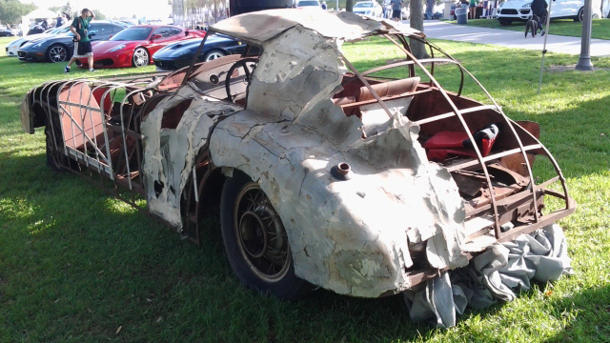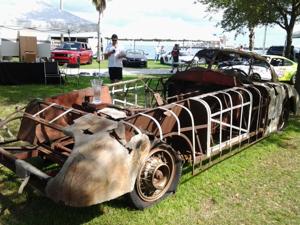 Fans of the show “American Pickers” may recall an episode where hosts Mike and Frank happened upon an old car thought to be a land speed record Pierce-Arrow from the late 1920s. A few months after the show aired, Tampa resident James McLynas stumbled upon the dilapidated machine and bought it. He's since posted the car throughout the Internet, started a Facebook page, and offered a reward, desperate to unearth the car’s origins. While some historical tidbits have surfaced, the “phantom” Pierce Arrow has stumped the Internet so far.
Fans of the show “American Pickers” may recall an episode where hosts Mike and Frank happened upon an old car thought to be a land speed record Pierce-Arrow from the late 1920s. A few months after the show aired, Tampa resident James McLynas stumbled upon the dilapidated machine and bought it. He's since posted the car throughout the Internet, started a Facebook page, and offered a reward, desperate to unearth the car’s origins. While some historical tidbits have surfaced, the “phantom” Pierce Arrow has stumped the Internet so far.
The previous owner originally purchased the machine with his father in 1988 from a warehouse in Ormond Beach, Fla., the center of high-speed racing in the early 20th century. From there, it sat in a muddy yard, neglected, for 25 years. When McLynas bought the car, the owner knew little of its historical roots. There's rumors that the machine was shown at the Chicago World’s Fair and the PanAmerican Show in the late 1930s, and it supposedly ran multiple times on the sand at Ormond and Daytona Beach – prior to the salt flats at Bonneville becoming the preferred destination for ultimate speed.
 Less than 24 hours after McLynas extracted the machine from the mud, he took it to the St. Petersburg Festival of Speed. The leaves, dirt, and grime hadn’t even been removed, and yet it won the coveted American Classic Spirit Award, “much to the dismay of many a polished Ferrari owner,” says McLynas.
Less than 24 hours after McLynas extracted the machine from the mud, he took it to the St. Petersburg Festival of Speed. The leaves, dirt, and grime hadn’t even been removed, and yet it won the coveted American Classic Spirit Award, “much to the dismay of many a polished Ferrari owner,” says McLynas.
Still, despite this attention and the incessant updates posted to relevant forums world wide, no substantial information has come forth. This led to McLynas naming the unknown machine the “Pierce Arrow Phantom.”
Here’s what we know so far:
The running gear dates from 1929, but heavy modifications are evident throughout, marking the car with a construction date possibly in the mid to late 1930s. McLynas considers the likelihood of this car being a “street speedster” or movie prop unlikely given the details already unearthed. For instance, there were never any lights, rear window, or even mirrors. The spark plugs were also welded to the heads, presumably to withstand the high engine compression during speed runs.
Additionally, with the air out of the tires, the transmission touches the ground; even with inflated rubber, the ground clearance is around four inches, making general usability difficult with the rough roads of the 1930s. This drastic ride-height reduction was accomplished by lowering blocks and modified springs.
The cockpit controls were even extended to allow the driver to sit closer to the rear axle. The door locks were electric, and on the dash, the gauges were traced to a P-40 aircraft, with the speedometer, operated via air pressure like a plane, maxing out at 300 mph.
Simply, this car screams custom-built speed.
The machine also runs on Pennsylvania Rubber Co. tires, and despite being rotten and coming apart, they show little signs of tread wear. Given the company ceased making car tires before World War II, McLynas thinks this denotes a pre-war build: “There is little doubt that these tires were not sitting around on a shelf unused throughout the war to later be purchased and installed on a post-war build.”
Using the engine number, the motor was traced to a late production 1931 Pierce-Arrow straight eight, with four separate intake manifolds for four one barrel carburetors. It has just 35 miles on the clock. It also has a fabricated gear drive, engineered to provide the correct RPM to run the 300-mph aircraft speedometer.
Even with these intricate details, the car’s identify remains shrouded in mystery. In an effort to unwrap the enigma, McLynas swathed the entire car in aluminum foil, offering clues as to how the original may have looked. As of today, that hasn't jarred loose any clues.
McLynas became so desperate for help he even offered a reward of $100 for anyone who can provide a genuine photograph, race history, or proof of builder. He also claimed to be “amazed” by the lack of facts revealed, despite his continuous hounding. And frankly, we are too. In today’s era, with experts living on forums, the lack of historical evidence strikes an odd note.
At some point, the mystery will surely be resolved, and the car’s future must then be determined: “Once we find out what it looked like, who built it, and what it did, we will formulate the next plan,” says McLynas. Having suffered a robbery a while back, losing all the tools he accumulated over the years, McLynas fears the eventual restoration may not be feasible in his hands: “This car will wind up fully restored for sure. I’m just not sure if I will be lucky enough to be a part of the process.”
With all his tireless work and commitment, we can only hope that won’t be the case. But first, we need to discover the true pedigree of this incredible historic shell. For now, it leaves the online communities and period experts thoroughly bemused. When the puzzle finally unravels and the Pierce-Arrow “Phantom” begets its rightful name, James McLynas can truly call himself the ultimate American picker.
Photo: James McLynas
Source: Yahoo!

No comments:
Post a Comment